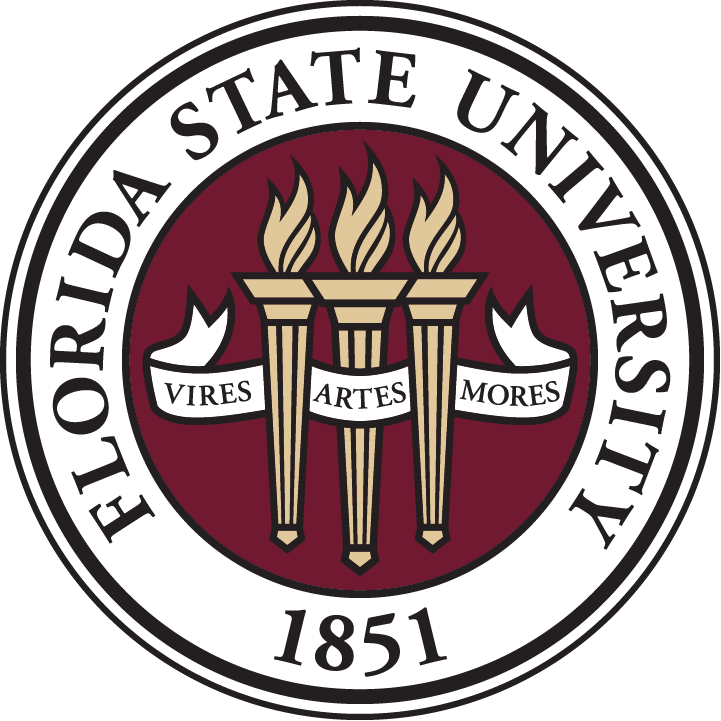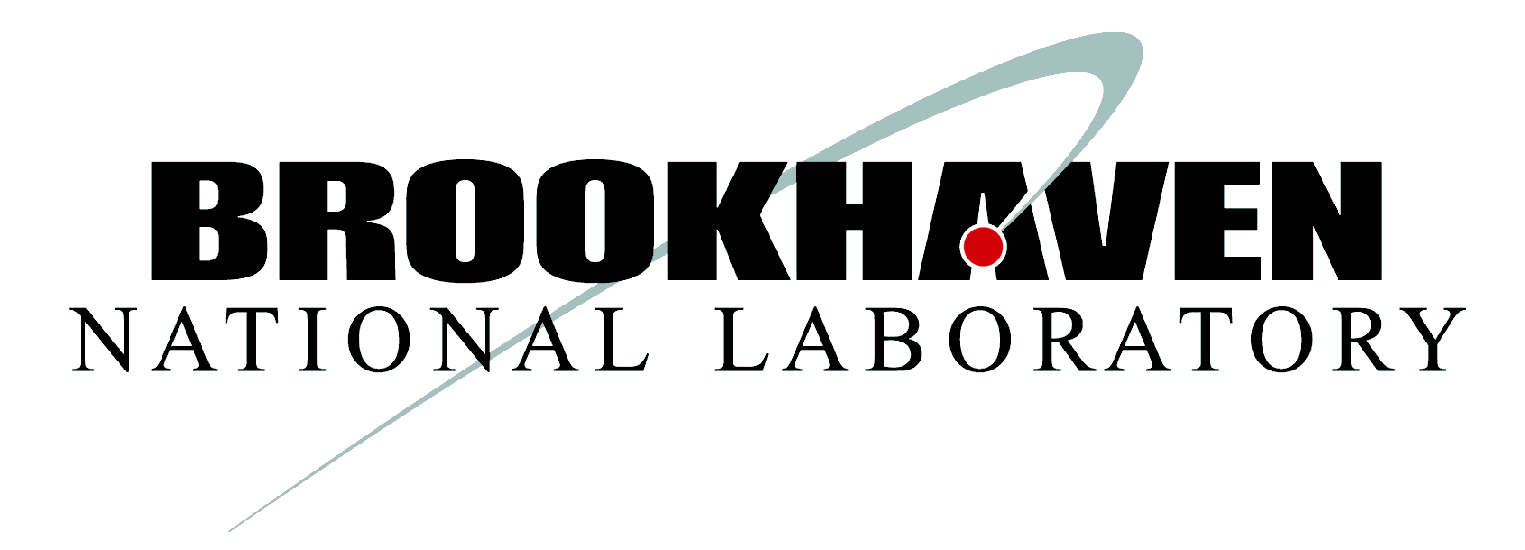Facilities
Materials and Fuels Complex (MFC) - Radiochemistry Laboratory (RCL)
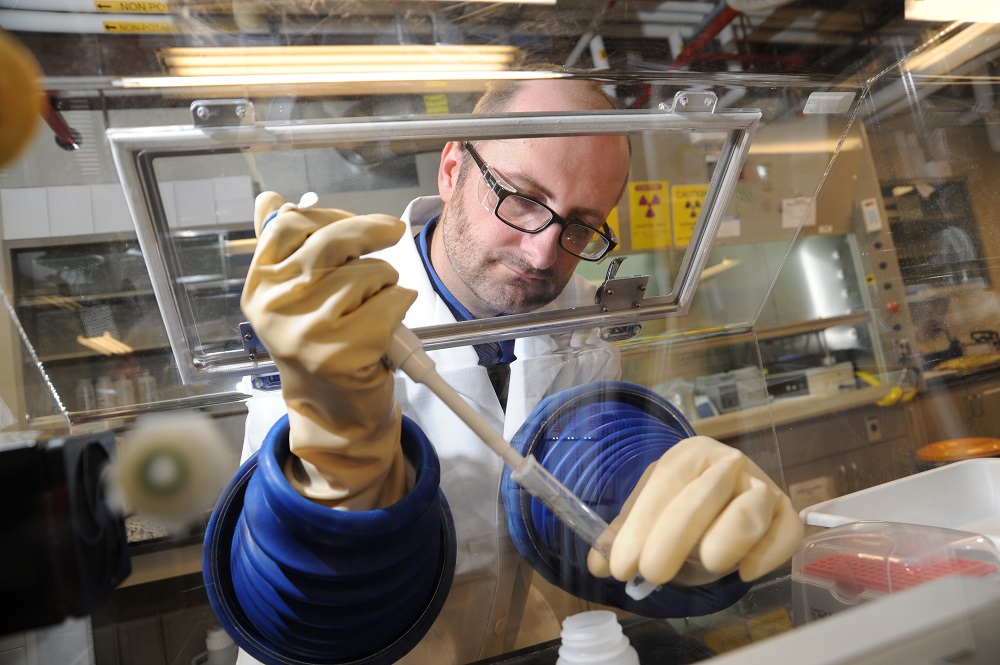
Home to the CR2, the MFC RCL facilitates experimental investigation in to the effects of radionuclide self-radiolysis on systems of both fundamental and applied interest, furthering our understanding into the mechanisms of radiation damage and effects of radiation quality.
The MFC RCL offers extensive state-of-the-art handling (seven active fume hoods, in addition to argon and air separations gloveboxes) and analytical capabilities (e.g., gamma-ray counters, liquid scintillation, and inductively coupled plasma-mass and optical emission spectrometry) for the preparation, characterization and post-irradiation examination of radionuclide containing solutions.
Materials and Fuels Complex (MFC) - Fuels and Applied Science Building (FASB) Irradiation Suite
The MFC FASB irradiation suite houses a MDS Nordion Gammacell 220 Excel cobalt-60 gamma irradiator. Offering un-attenuated dose rates of ≤1 Gy s−1, the Gammacell facilitates investigation into the effects of gamma rays on a wide range of materials and chemical systems, e.g., used nuclear fuel solvent extraction media, room temperature salt matricies, and a variety of commercial and bespoke metal alloys used in current and future nuclear reactor designs. These irradiation activities are supported by a Cary 6000 UV-Vis-NIR spectrophotometry, a bank of centrifugal contactors (CINC V-02, USA), and compressed gas cylinders regulated by an array of Sierra Instruments mass flow controllers.
In addition to catering for standard radiation chemistry experiments, two unique capabilities are offered:
1. Irradiation of Sealed Radionuclide Solutions. One of the CR2’s niche research capabilities is the capacity to investigate the effects of ionizing radiation on solutions containing a wide range of radioactive elements, e.g., neptunium and americium. Understanding radiation-induced redox chemistry is critical for a complete fundamental understanding of the chemistry of radioactive elements, in addition to their speciation and mobility under environmental and industrial conditions.
2. Bespoke Radiolysis and Hydrolysis Test Loop. To support a global initiative into the development of advanced used nuclear fuel reprocessing solvent system flowsheets, a series of bespoke test loop were designed and installed to evaluate the effects of gamma irradiation on the stability and performance of candidate solvent system formulations, under conditions more representative of industry, i.e., beyond the "benchtop." The initial U.S. test loop is made up of an irradiated volume contained in a borosilicate glass coil (∼75 feet in length, 0.375 inch outer diameter, 0.202 inch inner diameter), and an external stainless steel manifold, composed of a magnetic drive gear pump and a second stainless steel coil held in a temperature-controlled water bath to maintain loop solvent temperature. The second test loop...text...Although initially designed to validate the performance of new reprocessing schemes under extreme coupled conditions, these test loops are more than capable of accommodating other systems with potential for scale-up, for example Advanced Oxidation Process (AOP) water treatment procedures.
| 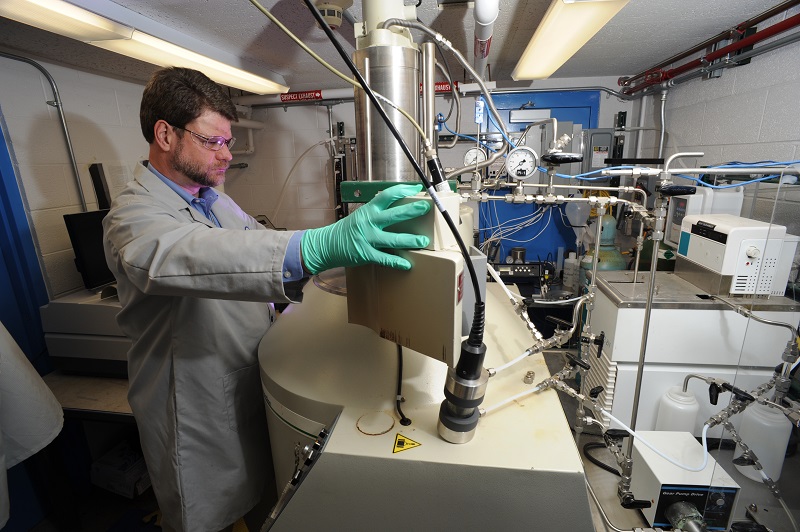 .png)
|
|
Energy Innovation Laboratory (EIL) Irradiation Suite
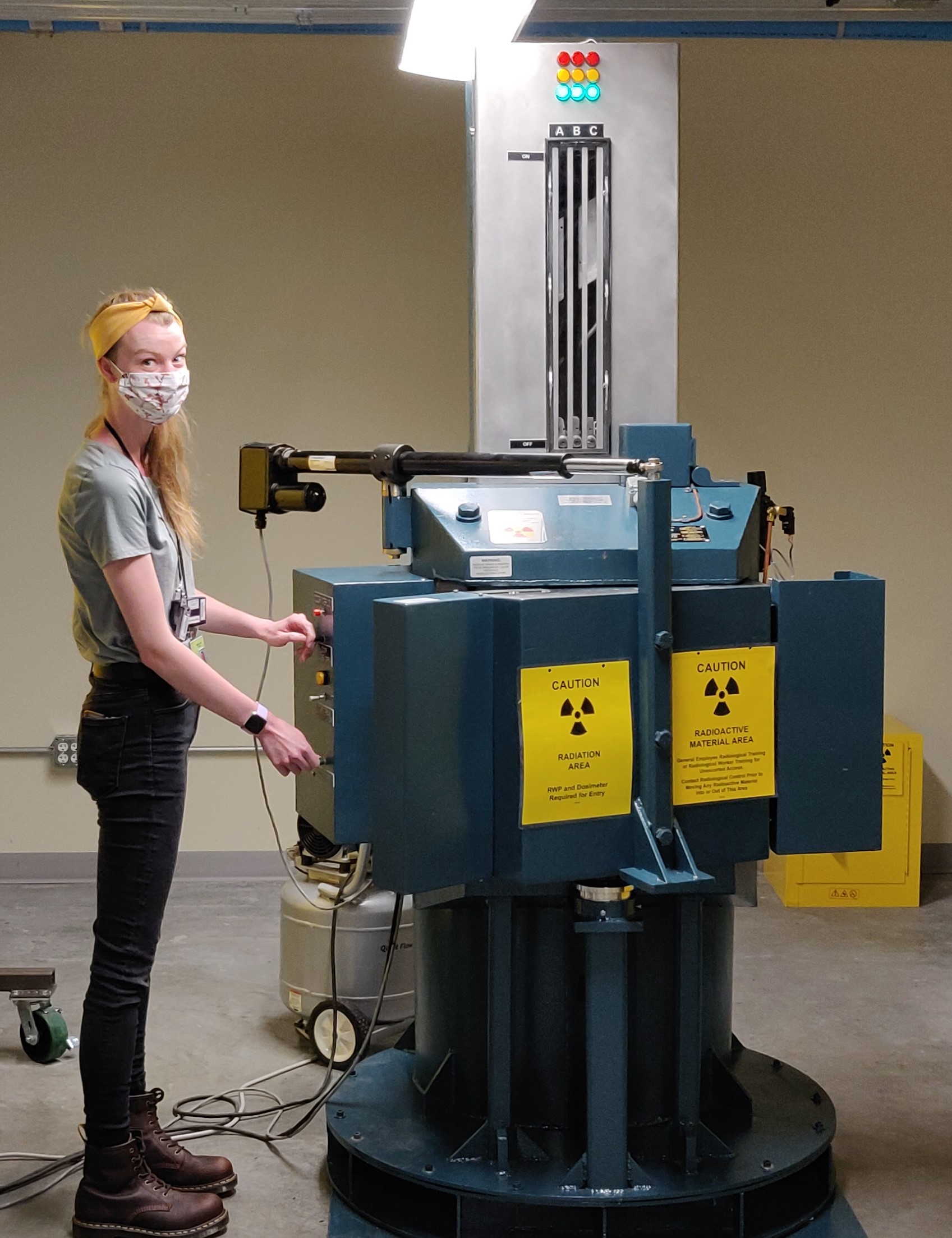 The EIL irradiation suite houses a recently installed Foss Therapy Service Model 812 cobalt-60 gamma irradiator.
The EIL irradiation suite houses a recently installed Foss Therapy Service Model 812 cobalt-60 gamma irradiator.
This capbility boasts un-attenuated dose rate of up to 500 Gy min−1, and is directly supported by the Mass Spectrometry and Chromatography Group's analytical instrumentation, which includes:
Current capabilities include a variety of nuclear research and test reactors; ion-beam accelerators; hot-cell post-irradiation-examination (PIE) equipment; advanced radiologically qualified materials science PIE instrumentation in low-activity laboratories; X-ray synchrotron, neutron, and positron beam lines; and high-performance computing. Compared with the “typical” U.S. government-supported user facility, the NSUF has a number of unique aspects. It is not a single stand-alone facility but instead a consortium of facilities each with its own set of capabilities and management structure and distributed across the United States. The capabilities of the NSUF are directed toward supporting a single industry — nuclear energy — as opposed to a single type of capability technology (e.g., X-ray synchrotron beams) that can be used to advance a wide range of industries.
Mass Spectrometry and Chromatography Group Instrumentation
Bruker micrOTOF-Q II Quadrupole Time-of-Flight Mass Spectrometer
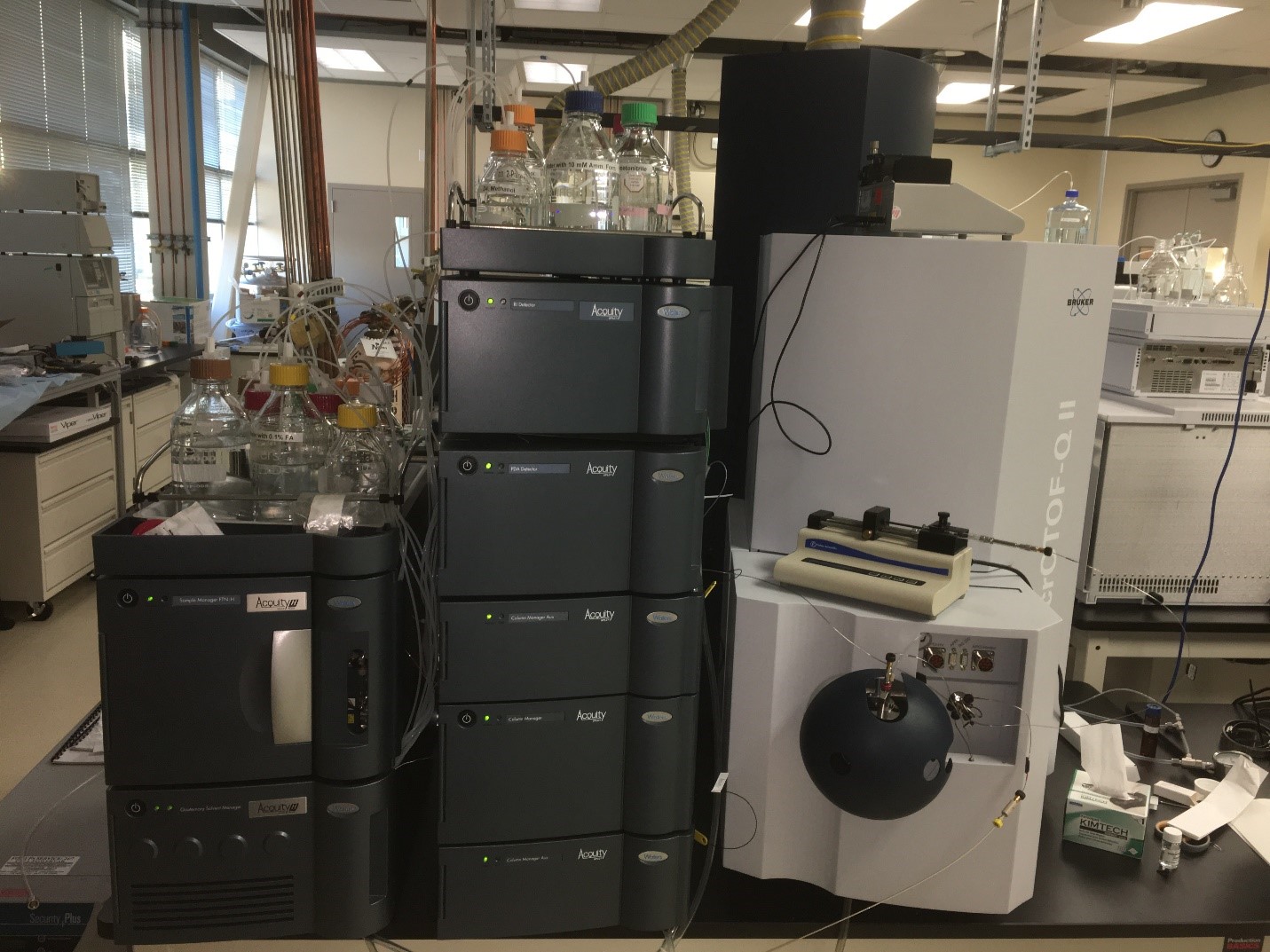
This instrument is a high-resolution accurate mass quadrupole-time-of-flight mass spectrometer, with electrospray, nanospray, atmospheric-pressure chemical ionization, and atmospheric-pressure photoionization sources with a mass range of 50-3000 m/z, an average resolution (m/Δm, width at 10%) of 8,000, and the capability to perform collision-induced dissociation (CID) tandem mass spectrometry experiments, up to MS2. This instrument is housed in laboratory space permitted to handle low-level uranium-containing radioactive samples. This instrument is connected to a Waters H-Class Plus Ultra High Performance Liquid Chromatorgaph (UHPLC), for chromatographic separation of samples prior to mass analysis. This instrument is primarily used for identification and quantification of organic unknowns, although it can also be used for cluster studies.
Bruker amaZon Speed ETD Ion Trap Mass Spectrometer
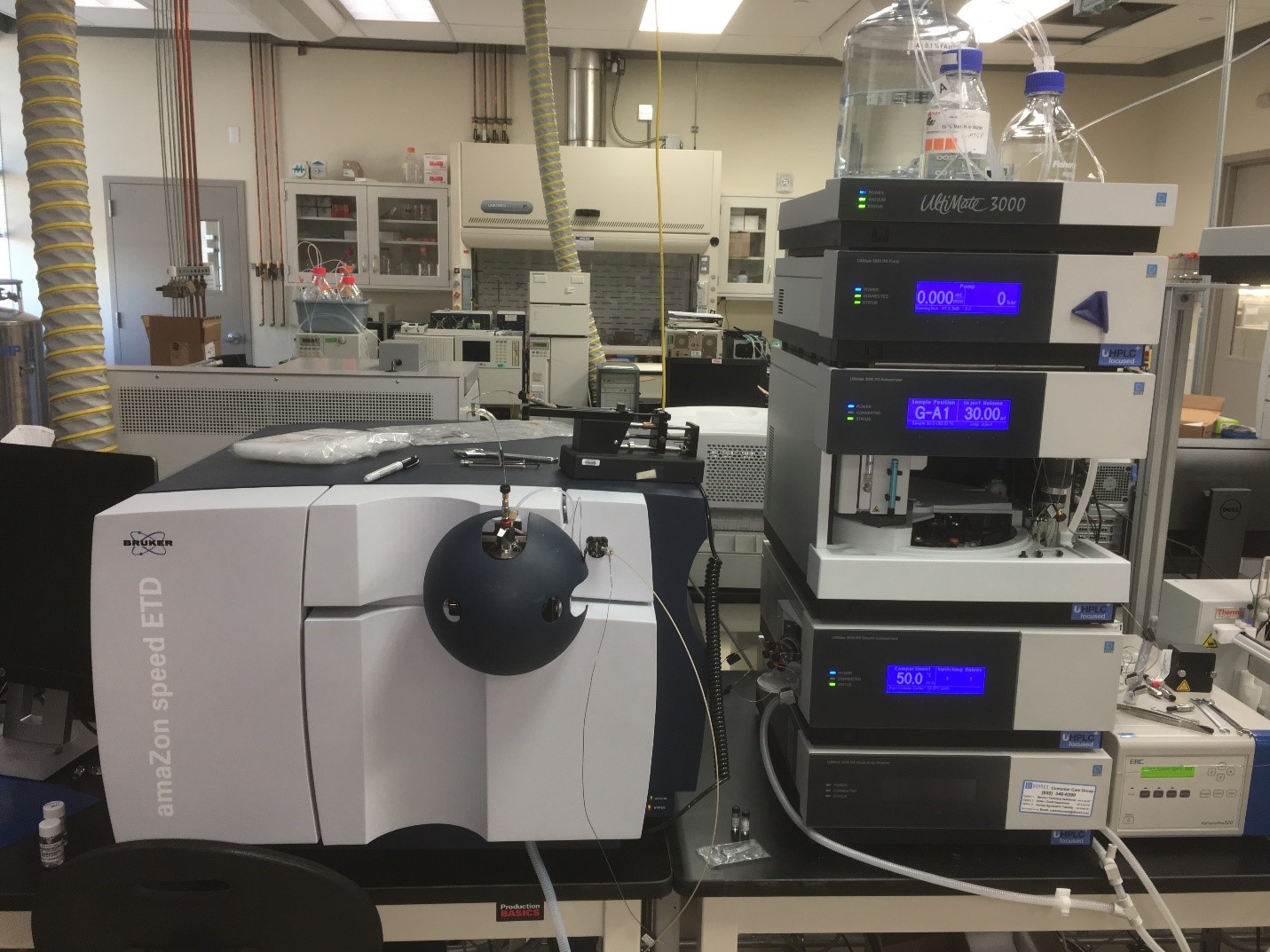
This instrument is a quadrupole ion trap mass spectrometer, with electrospray, nanospray, atmospheric-pressure chemical ionization, and atmospheric-pressure photoionization sources with a mass range of 25-3000 m/z and the capability to perform collision-induced dissociation, electron-transfer dissociation (ETD), and proton-reaction dissociation (PRD) tandem mass spectrometry experiments, up to MS9. This instrument is housed in laboratory space permitted to handle low-level uranium-containing radioactive samples. This instrument can be connected to a Thermo Dionex Ultimate 3000 Ultra High Performance Liquid Chromatorgaph (UHPLC), for chromatographic separation of samples prior to mass analysis. This instrument is primarily used for metal ligand cluster fragmentation studies, although it can also be used for identification and quantification of unknowns.
Thermo LCQ Deca XP Max Ion Trap Mass Spectrometer
This instrument is a quadrupole ion-trap with electrospray and nanospray ionization sources, with a mass range of 15-1200 m/z and the capability to perform collision-induced dissociation tandem mass spectrometry experiments up to MS10. This instrument is located in a Contamination Area, permitted to handle high-activity radioactive samples. This instrument is primarily used for metal ligand cluster fragmentation studies, although it can also be used for identification and quantification of unknowns.
Thermo LCQ Deca XP Plus Ion Trap Mass Spectrometer
This instrument is a quadrupole ion-trap with electrospray and nanospray ionization sources, with a mass range of 15-1200 m/z and the capability to perform collision-induced dissociation tandem mass spectrometry experiments up to MS10. This instrument is housed in laboratory space permitted to handle low-level and sealed radioactive samples. This instrument is primarily used for metal ligand cluster fragmentation studies, although it can also be used for identification and quantification of unknowns.
LECO Pegasus 4D 2-Dimensional Gas Chromatography Time-of-Flight Mass Spectrometer
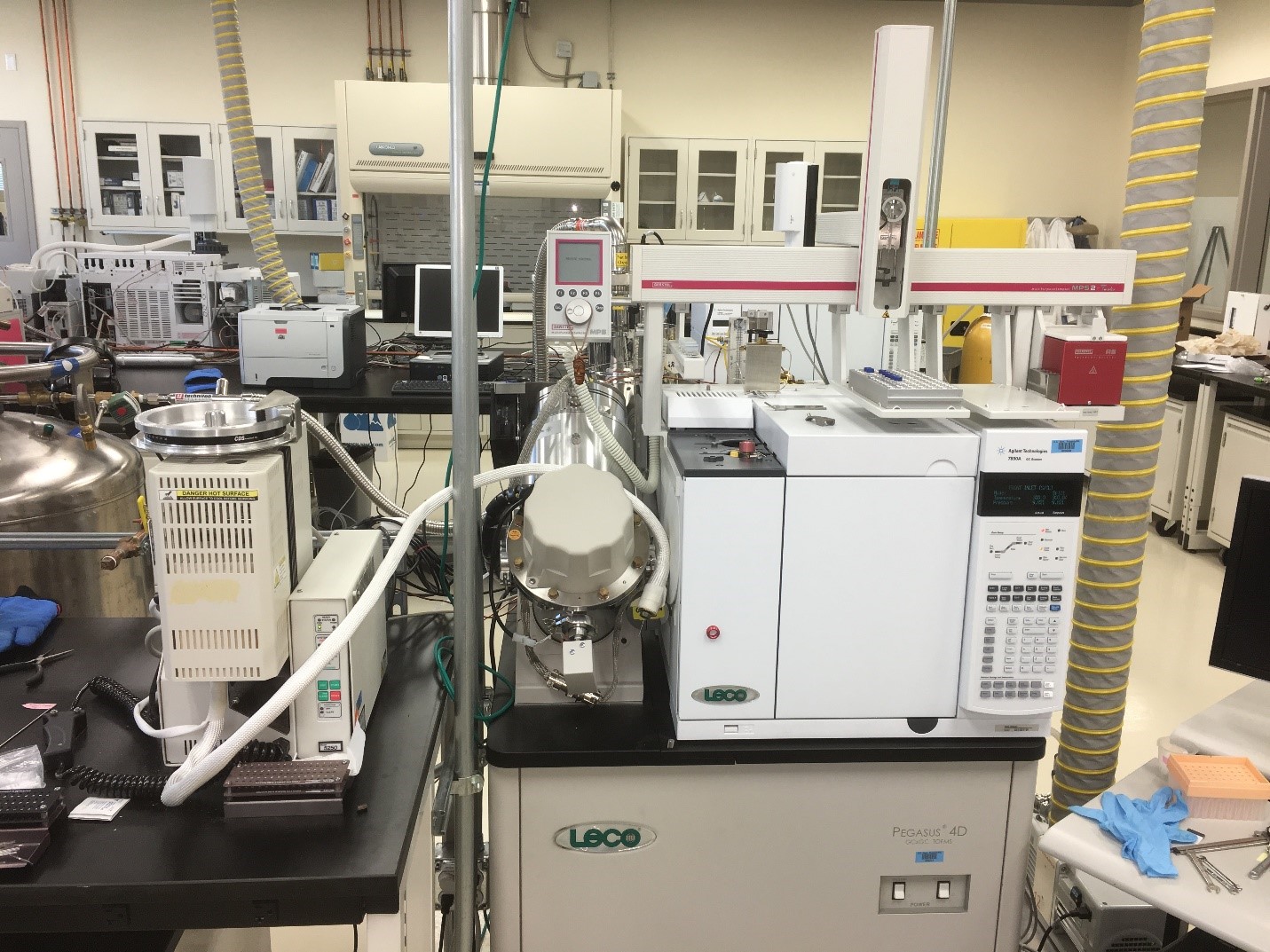
This instrument is a two-dimensional gas chromatograph with a time-of-flight mass spectrometer detector.The mass spectrometer has an electron impact ionization source, unit mass resolution, and a mass range of 10-1000 m/z. This instrument can be equipped with a CDS Analytical pyrolyzer for analysis of solids. This instrument is excellent for identifying organic components in very complex mixtures, and is adequate for quantification.
Other Gas-Chromatography Instruments
The facility has several single dimension gas chromatographs with mass spectrometry detectors. Most have single quadrupole mass analyzers with electron impact ionization, but one has a triple-quadrupole mass analyzer with electron impact, and positive and negative chemical ionization sources. The facility also has numerous gas chromatographs with flame ionization, barrier ionization, electron capture, flame photometric, nitrogen-phosphorous, and thermal conductivity detectors. Most instruments are configured for liquid analysis, though some are dedicated for gas and non-condensable analysis. These instruments are used for characterization of organic unknowns, and quantification measurements.
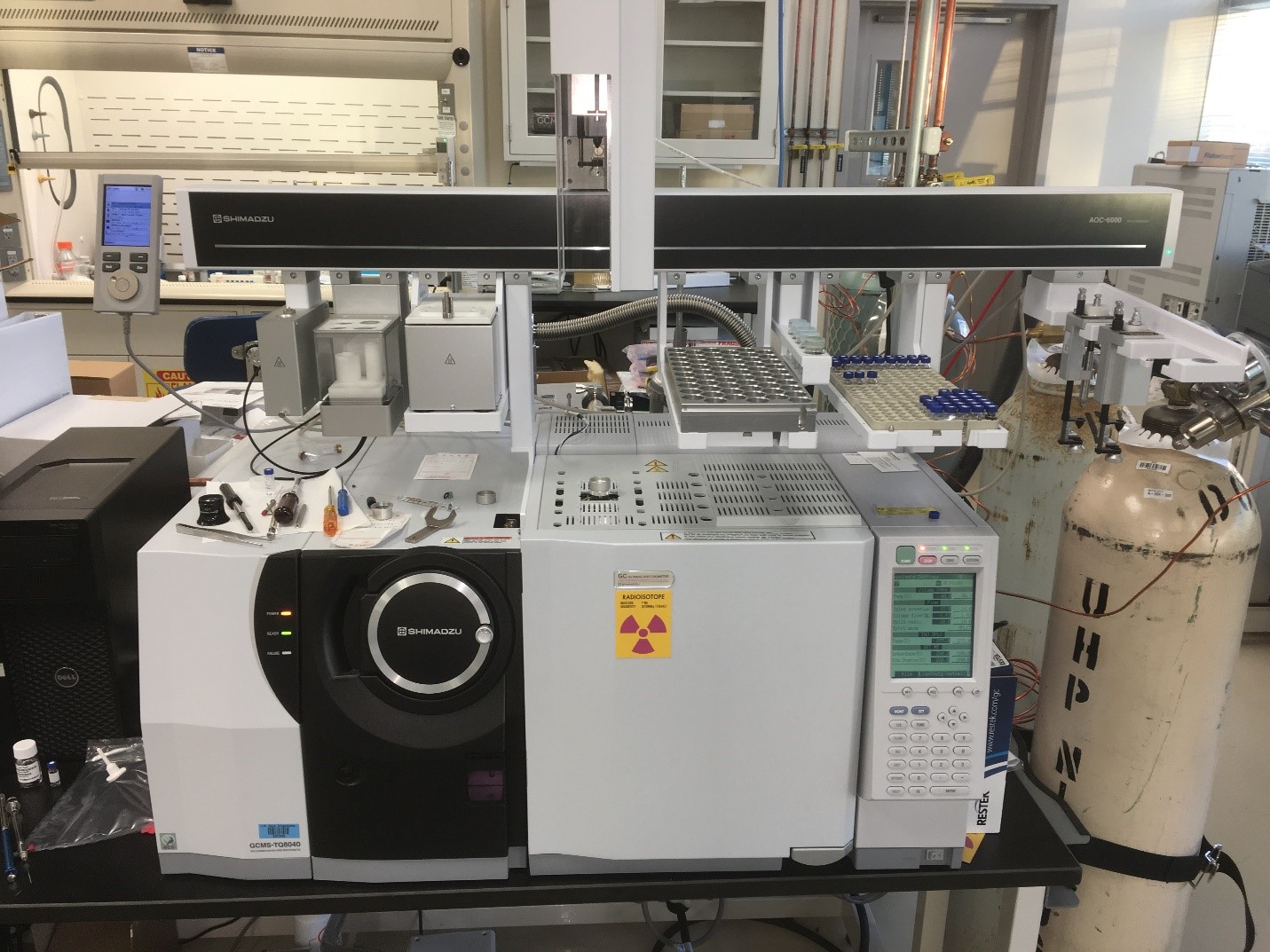
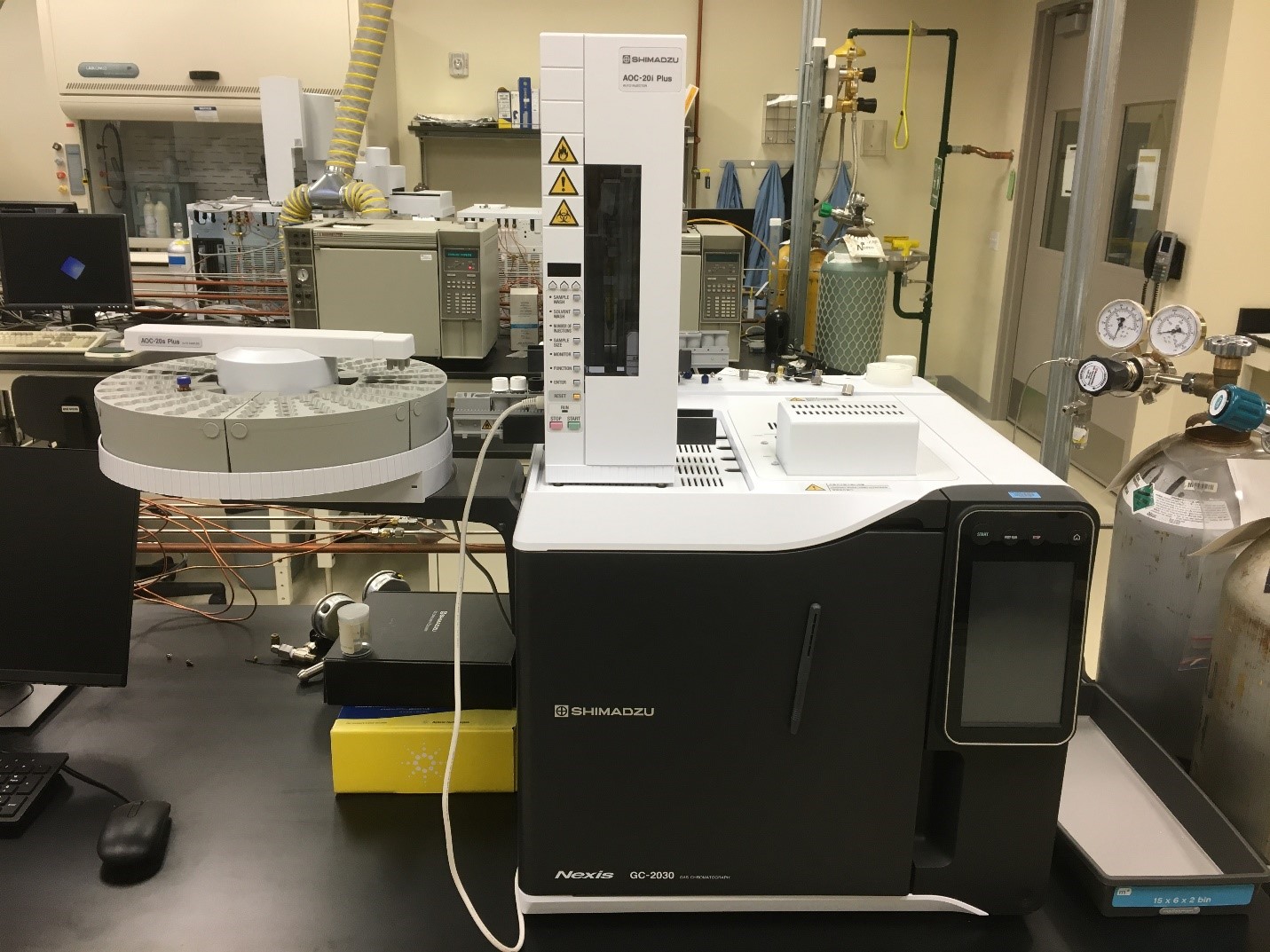
Nuclear Magnetic Resonance Instruments
The CR2 also has access to three NMR spectrometers: two high-field spectrometers for use on non-radioactive samples and one low-field spectrometer that is capable of handling radioactive samples as it resides at the MFC RCL.
The two high-field spectrometers are Bruker Avance III consoles coupled to cryomagnets with field strengths of 9.4 and 14.1 T (ν_(_^1)H = 400 and 600 MHz, respectively) and reside in the Energy Innovations Laboratory (EIL). The 9.4 T system is currently configured for a 4 mm solid-state Magic-Angle Spinning (MAS, νmax = 15 kHz) probe, but can be configured with a 5 mm broadband solution-state probe if the need arises. The broadband channel on the solid-state probe can be tuned from 15N to 31P (40 – 161 MHz). The 14.1 T system is dedicated to a room-temperature 5 mm solution-state probe with a broadband channel capable of tuning from 109Ag to 19F in frequency (28 – 564 MHz). This probe also includes a z-gradient, so experiments requiring gradient pulses can be used (e.g., Diffusion Ordered SpectroscopY, or DOSY). Finally, this system also includes the ability to run variable-temperature experiments between -150 and +80 °C.
The low-field spectrometer in RCL is an Anasazi Eft-90 coupled to a 2.1 T electromagnet (ν_(_^1)H = 90 MHz). This instrument has a 5 mm solution-state broadband probe that can be tuned from 29Si to 19F (17 – 84 MHz). As part of the RCL, millimolar concentrations of radioactive metals are available for use in experiments. There are plans to update RCL NMR capabilities by acquiring a high-field 9.4 T cryomagnet and Bruker Neo console with variable-temperature capabilities. This instrument is currently on the INL Integrated Priority List and would significantly increase the resolution of experiments with active samples at RCL.
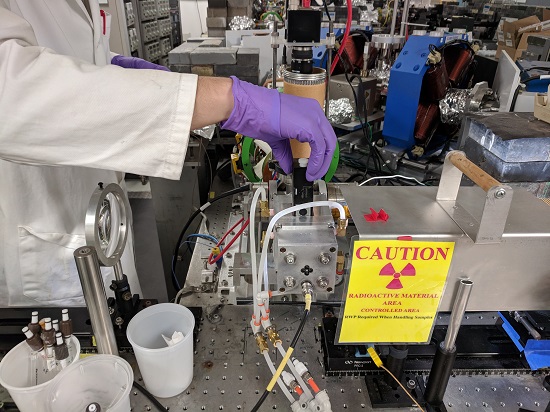
In addition to in-house capabilities and expertise, the CR2 is actively involved in collaborative efforts to pioneer new techniques. To this end, a new world-leading capability, in collaboration with Brookhaven National Laboratory (Dr. James F. Wishart) and Florida State University (Professor Thomas E. Albrecht-Schmitt), was established on Aug.1, 2018, Actinide Picosecond Pulse Radiolysis, for probing ultrafast radiation-induced redox chemistry of the actinide series in a variety of solvent system matrices. This capability was successfully evaluated using a series of aqueous uranium, curium, and californium targets to investigate the reaction kinetics of these ions with transient radiolysis products.
